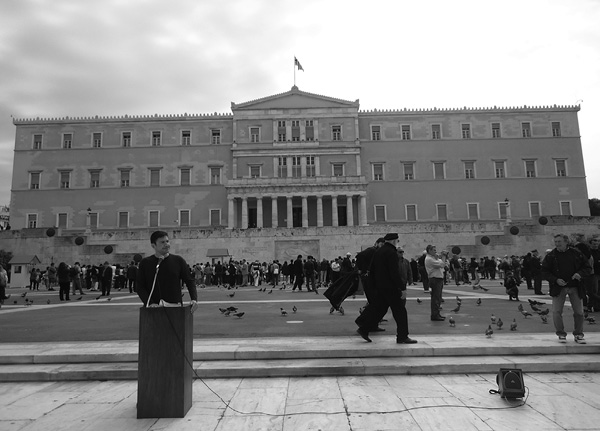
LAMBRAKIS LIVZ
first performed on
May 1, 2011
Syntagma, Athens, Greece
performed six times in 2011
STEFANOS MONDELOS, SPYROS ZOUPANOS, NAFSIKA TZANOU
Athens, Greece
205627031s205627031t205627031e205627031f205627031a205627031n205627031o205627031s205627031.205627031m205627031o205627031n205627031d205627031e205627031l205627031o205627031s205627031@205627031g205627031m205627031a205627031i205627031l205627031.205627031c205627031o205627031m
lambrakislivz.blogspot.com
LAMBRAKIS LIVZ
STEFANOS MONDELOS, SPYROS ZOUPANOS, NAFSIKA TZANOU
The performance “Lambrakis LivZ” is the re-enactment of the political speech of peace activist and MP, Grigoris Lambrakis, who was assassinated after a paramilitary plot in 1963. The life and death of Grigoris Lambrakis inspired the author Vassilis Vassilikos to write the political novel Z. The title denotes the first letter of the Greek word “Zei” (“[He] Lives!”), a popular graffito which began to appear on the walls of the buildings of the Greek cities in the 1960s, illustrating the growing protest against the conditions that led to the assassination of Lambrakis. In 1969, the Greek-French film director Costa-Gavras made the film Z. Gr. Lambrakis is dead but he is still alive haunting the imagination of any social struggle. The political speech of Gr. Lambrakis in June 1962, reflects all the political climate of his era (Cold War politics, peace and anti-nuclear weapons activism, Africa’s colonization and struggles of anti-colonization movements, NATO and German militarization, Communism peace plans, etc). The speech is a time-capsule and bears all the typical Greek and international leftist rhetoric of the polarized socio-politic climate of its era. But as outdated as it sounds to the contemporary ear there are certain fragments of the speech describing certain realities of the past that have a certain resonance to our present situation. It seems like certain realities of the past demanded resolution, remained unresolved and unchanged so far. This paradox of a speech of the past that at the same time retains its validity and its contemporaneity to the present situation is the starting point for the re-enactment of the speech. This paradox is intensified by the performance itself. For the staging of the performance no props or any costume for the performer were used in an attempt to mimic the 60’s era. Thus, the audience is confronted and puzzled with the paradox of a speech that although is clearly a part of the past, presented as contemporary, resonates to aspects of their present situation. The aim of the reenactment is to expose, in all its complexity, the problematic, tricky and contradictory oxymoron of a legacy that still haunts the imagination of any social emancipating practice by revealing and bringing to the fore these paradoxes. The performance was presented six times in different open spaces in Athens, Greece on certain occasions (May Day, speech’s anniversary June 23, anniversary of Athens liberation from the WWII German’s occupation October 12, etc).